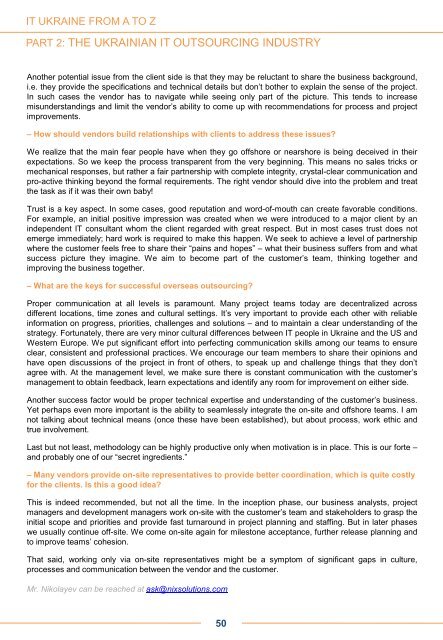IT UKRAINE
ua_hightech
ua_hightech
Create successful ePaper yourself
Turn your PDF publications into a flip-book with our unique Google optimized e-Paper software.
<strong>IT</strong> <strong>UKRAINE</strong> FROM A TO Z<br />
PART 2: THE UKRAINIAN <strong>IT</strong> OUTSOURCING INDUSTRY<br />
Another potential issue from the client side is that they may be reluctant to share the business background,<br />
i.e. they provide the specifications and technical details but don’t bother to explain the sense of the project.<br />
In such cases the vendor has to navigate while seeing only part of the picture. This tends to increase<br />
misunderstandings and limit the vendor’s ability to come up with recommendations for process and project<br />
improvements.<br />
– How should vendors build relationships with clients to address these issues?<br />
We realize that the main fear people have when they go offshore or nearshore is being deceived in their<br />
expectations. So we keep the process transparent from the very beginning. This means no sales tricks or<br />
mechanical responses, but rather a fair partnership with complete integrity, crystal-clear communication and<br />
pro-active thinking beyond the formal requirements. The right vendor should dive into the problem and treat<br />
the task as if it was their own baby!<br />
Trust is a key aspect. In some cases, good reputation and word-of-mouth can create favorable conditions.<br />
For example, an initial positive impression was created when we were introduced to a major client by an<br />
independent <strong>IT</strong> consultant whom the client regarded with great respect. But in most cases trust does not<br />
emerge immediately; hard work is required to make this happen. We seek to achieve a level of partnership<br />
where the customer feels free to share their “pains and hopes” – what their business suffers from and what<br />
success picture they imagine. We aim to become part of the customer’s team, thinking together and<br />
improving the business together.<br />
– What are the keys for successful overseas outsourcing?<br />
Proper communication at all levels is paramount. Many project teams today are decentralized across<br />
different locations, time zones and cultural settings. It’s very important to provide each other with reliable<br />
information on progress, priorities, challenges and solutions – and to maintain a clear understanding of the<br />
strategy. Fortunately, there are very minor cultural differences between <strong>IT</strong> people in Ukraine and the US and<br />
Western Europe. We put significant effort into perfecting communication skills among our teams to ensure<br />
clear, consistent and professional practices. We encourage our team members to share their opinions and<br />
have open discussions of the project in front of others, to speak up and challenge things that they don’t<br />
agree with. At the management level, we make sure there is constant communication with the customer’s<br />
management to obtain feedback, learn expectations and identify any room for improvement on either side.<br />
Another success factor would be proper technical expertise and understanding of the customer’s business.<br />
Yet perhaps even more important is the ability to seamlessly integrate the on-site and offshore teams. I am<br />
not talking about technical means (once these have been established), but about process, work ethic and<br />
true involvement.<br />
Last but not least, methodology can be highly productive only when motivation is in place. This is our forte –<br />
and probably one of our “secret ingredients.”<br />
– Many vendors provide on-site representatives to provide better coordination, which is quite costly<br />
for the clients. Is this a good idea?<br />
This is indeed recommended, but not all the time. In the inception phase, our business analysts, project<br />
managers and development managers work on-site with the customer’s team and stakeholders to grasp the<br />
initial scope and priorities and provide fast turnaround in project planning and staffing. But in later phases<br />
we usually continue off-site. We come on-site again for milestone acceptance, further release planning and<br />
to improve teams’ cohesion.<br />
That said, working only via on-site representatives might be a symptom of significant gaps in culture,<br />
processes and communication between the vendor and the customer.<br />
Mr. Nikolayev can be reached at ask@nixsolutions.com<br />
50


